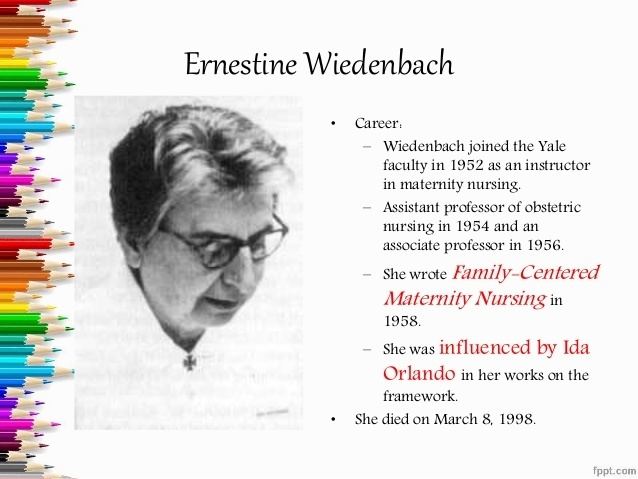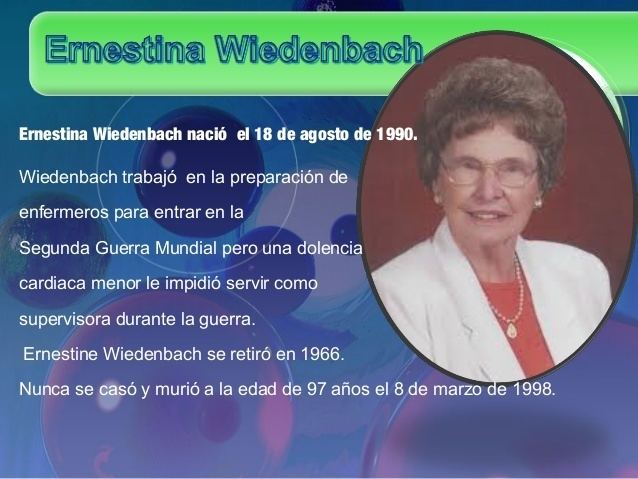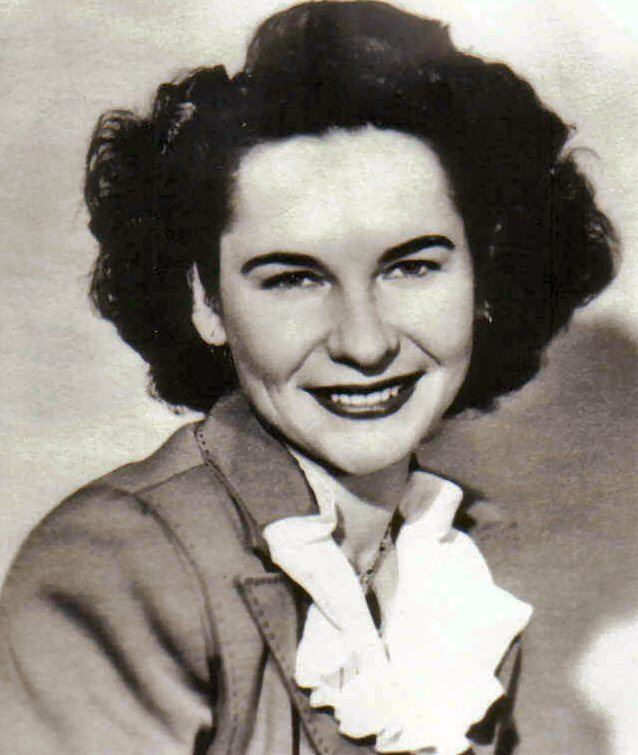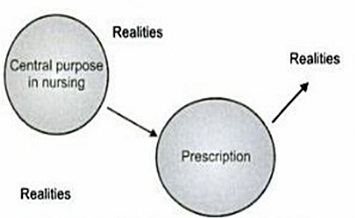Name Ernestine Wiedenbach | Role Author | |
 | ||
Died March 8, 1998, Florida, United States Books Clinical nursing, a Helping Art, Communication: Key to Effective Nursing, Meeting the Realities in Clinical Teaching Education Johns Hopkins School of Nursing, Wellesley College, Columbia University | ||
Ernestine Wiedenbach (August 18, 1900 in Hamburg, Germany – March 8, 1998) was a nursing theorist. Her family moved to New York in 1909. She received a B.A. from Wellesley College in 1922, an R.N. from Johns Hopkins School of Nursing in 1925, an M.A. from Teachers College, Columbia University in 1934, and a certificate in nurse-midwifery from the Maternity Center Association School for Nurse-Midwives in New York in 1946, where she also taught until 1951. Wiedenbach became a member of the Yale faculty in 1952, serving as an instructor in maternity nursing. In 1954, she was appointed as an assistant professor of obstetric nursing and was promoted to associate professor in 1956. This promotion coincided with the establishment of a master's degree program at the Yale School of Nursing, within which she led the major in maternal and newborn health nursing. Wiedenbach is credited with authoring several textbooks extensively utilized in nursing education. She retired in 1966.

Works


Wiedenbach’s Theories 1. Prescriptive theory: a situation producing theory. Directs action toward an explicit goal. Has three factors: Central purpose (nurses philosophy for care) Essential to the particular discipline. Prescription for the fulfillment of the central purpose, directive to activity. Realities in the immediate situation that influence the fulfillment of the central purpose. Matrix in which the action occurs. Central purpose Philosophy underlies purpose and purpose reflects philosophy, Wiedenbach(1969). 3 components for nursing philosophy: Reverence for the gift of life. Respect for the dignity, worth, autonomy, and individuality of each human being. Resolution to act dynamically in relation to one’s beliefs. The prescription Actions appropriate to implement a plan to carry out the actions in accordance with the central purpose. Actions may be voluntary (intended response), or involuntary (unintended response). 3 voluntary actions: Mutually understood and agreed upon action. The recipient understands the implication of the action and is receptive to it. Recipient-directed action. Recipient directs the way the action is carried out. Practitioner-directed action. Practitioner carries out the action. The realities. After the nurse determines the central purpose and has developed the prescription she considers the realities. There are five realities: The agent. Has 4 basic responsibilities 1. To reconcile assumptions about the realities. 2. To specify the objectives. 3. To practice nursing according to the objectives. 4. To engage in related activities that contributes to self-realization and the improvement of nursing. The recipient, or patient is vulnerable and is depended on others for help and risks losing their individually, dignity, worth, and autonomy. The goal or directed outcomes the nurse wishes to achieve. The means or activities that the nurse is empowered to achieve the goals. The framework consists of the human, environmental, professional, and organizational facilities. 2. Weidencach’s conceptualization of nursing practice and process. Nursing practice is an art, which the nursing action is based on the principles of helping. Consists of 4 actions. 1. Reflex (spontaneous). 2. Conditioned (automatic). 3. Impulsive (impulsive). 4. Deliberate (responsible). The nursing practice has 3 components. 1. Identification of the patient’s needs. 2. Ministration of help needed. 3. Validation of the action taken. The clinical nursing has 4 components. 1. Philosophy, personal position of the nurse toward reality. 2. Purpose, overall goal. 3. Practice, includes 4 components: Identification or need for help. Ministration of help needed. Validation of the help needed. Coordination of help and resources for help. 4. Art of clinical nursing requires using individual interpretations of behavior in meeting needs for help. Identification for the need of help involves: Observing inconsistencies and acquiring information about patient’s needs. Determining whether the patient can meet the need for help. Determining the cause of the discomfort or need for help.


